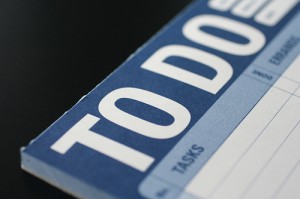 If your teen plans to enroll in a college degree program after high school, there’s a lot to think about.
If your teen plans to enroll in a college degree program after high school, there’s a lot to think about.
You’ll find helpful posts and links in the Education section of our Free Transition Tools page.
But it can be a challenge to take action on all this information.
What specific steps should your teen take in each year of high school?
Let’s look at two college planning checklists that help to answer that question.
No checklist is perfect
Your teen’s particular talents, interests and support needs are unique. No checklist will include every step needed to successfully plan for college. You and your teen must ask very specific questions of the high school guidance counselor and college disability support staff. They can direct you to resources relevant to your teen’s specific situation.
But these two checklists, taken together, include steps all teens with disabilities should take as they plan for college.
Going-To-College.org High School To-Do Lists
Videos by peer mentors are built right into the steps of these year-by-year action plans. How cool is that?
By clicking a link in the action step, your teen will connect with videos of college students with disabilities sharing their personal experiences and explaining why the step is important.
The To-Do lists include learning key skills, developing habits, researching colleges and support services, self advocacy, goal setting and problem solving, assistive technology, course selection, application processes, financial aid and much more.
A real bonus is the Going to College Portfolio. Teens are prompted at various points throughout high school to add information to this electronic organization system. When it’s time to apply for college - voila! They’ll have what they need in one place!
Ready to check it out for yourself? You’ll find the Going-To-College To-Do Lists here. While you’re there, check out the rest of the site. It’s an incredible resource!
PSU Parent/Student Checklist
The year-by-year checklist developed by the Penn State University Office for Disability Services is more general. But it has its own advantages. And it’s been used by many families throughout the country.
A key feature is that action steps for both the student and the parents are included. As teens progress through high school, the parental role changes. Students gradually increase their self-advocacy and planning responsibilities. By graduation, kids are better prepared to speak and act for themselves in college.
This succinct checklist can be printed and shared with school guidance and transition staff, so that transition is a collaborative process.
You can download the PSU checklist here.
Your turn
Please share your experiences with these or other college planning tools. We’ll all benefit from your perspective.
If you find this post helpful, please share it. Thanks!
Photo credit: Courtney Dirks at Flickr


